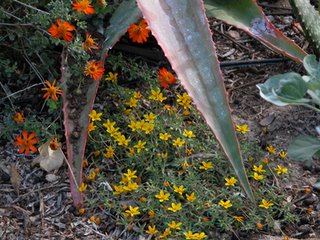Friday, February 24, 2006
More Weeds
 I now have a keen eye for seedlings. My rule of thumb for weeding, is "if I don't know what it is, then don't pull it". I recognized the seedling in the middle as an orange-flowered native, Dogweed (Dyssodia speciosa) and have transplanted it to a more desireable location. The blue-leafed groundcover is Sesuvium verrucosum, another native, that has become a favorite. It has nice pink flowers year round. Now, when I'm cruising through the garden, I'm also looking for interesting seedlings.
I now have a keen eye for seedlings. My rule of thumb for weeding, is "if I don't know what it is, then don't pull it". I recognized the seedling in the middle as an orange-flowered native, Dogweed (Dyssodia speciosa) and have transplanted it to a more desireable location. The blue-leafed groundcover is Sesuvium verrucosum, another native, that has become a favorite. It has nice pink flowers year round. Now, when I'm cruising through the garden, I'm also looking for interesting seedlings.
Wednesday, February 22, 2006
Seeing Differently
 When a plant is done flowering, my instinct is to tidy it up by cutting all dried flower stems. One recent day, I looked with a fresh eye and decided that the old dried flowers and stems were actually interesting and should stay. See the dried up pinkish Kalanchoe flowers in the center of the photo and the tall dried Aloe vera flower stalks at the top.
When a plant is done flowering, my instinct is to tidy it up by cutting all dried flower stems. One recent day, I looked with a fresh eye and decided that the old dried flowers and stems were actually interesting and should stay. See the dried up pinkish Kalanchoe flowers in the center of the photo and the tall dried Aloe vera flower stalks at the top.
Sunday, February 12, 2006
Queen Butterfly Caterpillar

I'm trying to figure out what the larval host plants are for the different butterflies so I can have them in my garden to attract more butterflies. This is a Queen butterfly caterpillar munching on Jumete (Asclepias subulata) flower buds. Queens are related to Monarchs and the caterpillars look somewhat similar. Jumete is in the Milkweed plant family (Asclepiadaceae) and Monarchs like Milkweeds too. A couple of hours after taking this photo, I walked by the plant and the caterpillar was gone--maybe one of the birds ate it for breakfast.
Limones

Two of the lime trees are dripping with blossoms and wafting their heavenly fragrance for all to enjoy. These are Mexican limes--the same as Key Limes. What many people don't realize, is that they are juiciest and sweetest (and make the best margaritas and Key Lime Pie) when the skins are yellow--not green. When fully mature, they drop and you can harvest from the ground. Prune the lower branches to avoid serious thorns.
Another Weed.....

This is Justicia insolita, a wonderful perennial native I've grown for several years. It blooms almost year-round and flowers best in full sun. There is so much potential here for gardening with natives. I feel a sense of discovery when I get another native with horticultural potential established in my garden.
Tuesday, February 07, 2006
Roadrunner

This morning I saw two roadrunners in the garden at the same time. I've been seeing at least one every other day lately, and they are letting me get closer. This photo was taken from my art studio window. I just moved the birdbath so I can see it through the window. Makes it hard to get any work done. Once I saw a roadrunner near our birdbath trotting away victoriously with an oriole in its mouth!
Saturday, February 04, 2006
A Book for All Desert Gardeners

I'm pretty sure I would be embarrassed if I ever actually counted the hours I have spent poring over this book. I know every photo, just like you know every song on a favorite CD. I know where the photographer was standing to take each photo......
It definitely inspired my gardening and photography. Highly recommended.











